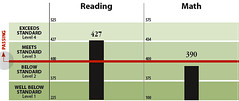Sunday, September 24, 2006
State testers fail math
But that's not the topic of this post. Instead, I'd like you to look at the sample bar chart, taken from this annotated example. It's not too dissimilar from what we received for our daughter, except for details such as her scores and comparisons with her school, school district, and state averages.
Look at the vertical scale for this bar chart. The first thing we notice is that the Y axis doesn't start at zero, yet there is no indication in the bars that their bottoms are cut off. Maybe we could dismiss this; perhaps the purpose of this graph is to show differences (more obvious in what we got, which has multiple bars). But look at the numbers on the Y axis: each of the four categories takes up the same space on the axis, even though their ranges vary widely, from a minimum of 25 to a maximum of 275!
In other words, the vertical scale provides no useful information, and in fact is misleading in implying that all four categories have similar ranges. Not only that, but by sharing ranges between reading and math, the fact that the ranges for the same categories differ is obscured.
So, the heights of the bars are meaningless. Bars with tops in different categories cannot be compared because of the nonlinear scaling. Bars in different tests cannot be compared. About the only information conveyed by this graph is the category that the student in question's score fell within, and possibly the relative position within that category. This begs the question: if the folks who design the WASL report can produce such a bad graph, how confident can one be in the rest of the testing and scoring process?
Topics: education, testing.
Posted by
Michael Stiber
|
9/24/2006 11:09:00 AM
|
0
comments
|
![]()
Monday, September 18, 2006
Travel photo of the week
In China, caves are used to tell stories, like you might do when looking up at the clouds. Tours focus on historical and mythological figures and events, as if the rock formations were dioramas. Alternatively, areas are lit up like a light show. The cave experience becomes a cultural one.
Posted by
Michael Stiber
|
9/18/2006 11:46:00 PM
|
0
comments
|
![]()
Friday, September 08, 2006
Bicycle commuting
There comes a time in everyone's life when you must decide: exercise or start saving for coronary bypass surgery. I've been running more, but sometimes things are just too busy for me to fit a run in. That, plus my previously-voiced frustration over the lack of progress in car fuel efficiency by automakers (despite existing modifications that can yield 100 miles/gallon), led me to think seriously about bicycling commuting.
I've ridden to work before, and do so when the weather is nice: one way. After work, my wife would then pick me and the bike up. The main reason for this is that we live at the top of one of the (if not the) tallest hills in the area. I decided that I would see if I could ride up, so that I could commute both ways by bike, and in fact it seemed feasible when I tried. I'm in OK shape, but from running, not biking, and only had to walk two half blocks (the steepest parts of the route -- steep enough that you might wonder if your car can make it). This leads me to believe that I'll be able to do the climb without stopping one day, and it's always nice to have a goal to shoot for.
Next comes the strategy to avoid procrastination and backsliding ("I'm a bit tired today; I'll bike in tomorrow," where tomorrows eventually become months). Part of this involves buying equipment to set my bike up properly. I've got a 7 or 8 year old Raleigh R300 touring road bike; I outfitted it with fenders, added a flashing tail light, and am in the process of getting a good, bright headlight (I already had a rear rack and panniers). I also bought tools (I used to do all my bike maintenance, but got rid of all my tools after grad school). Now if I don't commute, I'll feel like I wasted all that money. I also estimate that we'll be saving about $20/week on gas (the commute is a bit over 5 miles, one way, we only own one car -- an all-wheel-drive Dodge Grand Caravan -- so my wife often drops me off at work in the morning and makes another trip in the evening to pick me up; it adds up). I get about an hour or so of exercise per day, broken into two parts each of which increases my metabolism for an extended period of time afterwards.
I found an enormous number of bicycle commuting resources on the web. I'll just point out one: Paul Dorn's Bike Commuting Tips.
P.S. If you're biking home from work and it's uphill all the way, eat a snack beforehand.
Topics: bicycling, transportation, environment, exercise.
Posted by
Michael Stiber
|
9/08/2006 04:51:00 PM
|
0
comments
|
![]()
Thursday, September 07, 2006
On the value of computers for primary education
Daniel Lemire commented on a previous post of mine, and I thought I had an elaboration that merited a post, rather than burial in a comments thread. I had written that computers could be useful as tools in primary school, but not as objects of study themselves. He suggested a parallelism with pencils, etc., and yes, those other things are tools, too. But, while those are necessary, I don't believe that computers are necessary tools. Potentially useful, yes, but kids can learn the same things without computers. Here's a quote by Alan Kay from "Revealing the Elephant: The Uses and Misuses of Computers in Education":
Suppose it were music the nation is concerned about. Our parents are worried that their children won't succeed in life unless they are musicians. Our musical test scores are the lowest in the world. After much hue and cry, Congress comes up with a technological solution: 'By the year 2000 we will put a piano in every classroom! But there are no funds to hire musicians, so we will retrain the existing teachers for two weeks every summer. That should solve the problem!' But we know that nothing much will happen here, because as any musician will tell you, the music is not in the piano!
Posted by
Michael Stiber
|
9/07/2006 09:18:00 AM
|
1 comments
|
![]()
Wednesday, September 06, 2006
Garden photo of the week
Posted by
Michael Stiber
|
9/06/2006 08:57:00 AM
|
0
comments
|
![]()
Labels: gardening
Tuesday, September 05, 2006
A computer for young children
So, clearly the AlphaSmart is fairly basic. The newer models are fancier, but as you can see from the web site, they are still limited, they run a proprietary OS that requires the purchase of additional software from the manufacturer, and they cost $400! Given the recent project to develop a $100 laptop for education, this seems excessive.
What does a young child need in a laptop? She needs durability (so no hard drive or thin lid with large display), reasonable battery life (so no hard drive), simplicity (so the OS needs to be hidden), a keyboard (no palmtops), and basic connectivity. It occurred to me that all of these things were features of my old Newton MessagePad 2100, except for the keyboard. But there was another machine using the Newton OS: the eMate. And the eMate fits this task perfectly, including the simplicity and power of an OS that is still unmatched today. This includes instant on, no need to explicitly save documents, the ability to install additional software, non-volatile memory (so there's no danger of you ever losing a file, unless you delete it), stylus and keyboard, etc., etc. Others have commented on using the eMate as a child's computer. You can get an eMate on eBay for less than $30, including shipping costs, which is a nice feature, too. The only question was: could I get it to work with today's computers?
Power
Some of the eMates on sale on eBay will have power
supplies and some
won't. The one I bought didn't; a Radio Shack 3-7.5V, 2A digital camera
power supply (catalog number 273-1696) works fine. Though nominally
the eMate requires 7.5V (the original power supply was rated 7.5V,
1.2A), I found that the eMate complained about 7.5V but was happy
with the power supply set to 7V.
Batteries are another matter. Odds are, the eMate you buy will have an original NiMH battery pack that doesn't hold much of a charge. You can either replace the cells in the batter pack or replace the battery pack with a holder for 4 AA batteries. As of this writing, I'm planning to do the latter.
USB Interface
The eMate has a built-in serial connector. I had a Keyspan USA-19Qi serial to USB adapter from an old Palm that I'm no longer using. However, the eMate's serial port uses a Apple mini DIN-8 connector, while the Keyspan uses a PC style DB9 connector. I had some Apple style and PC style cables and was able to make a DIN-8 to DB9 cable, given some information about the pinouts of the two ports. No doubt, I could have bought something somewhere, but I had the hardware and expertise to do it.
Mac OS X Software
Here you're in luck, as there is a (somewhat) active developer community out there for the Newton OS (which says something about the hardware's longevity). The software I chose is NewtSync, which aspires to be an iSync-like program for the Newton. It requires software on the eMate side, too, which can be installed using the NewTen package installer. With the TextSync plugin, my daughter can write papers using the eMate Notes program and then sync the notes to a Mac running OS X. Works like a charm. With other plugins, a Newton can be a perfectly usable PDA.
Posted by
Michael Stiber
|
9/05/2006 06:35:00 PM
|
2
comments
|
![]()








